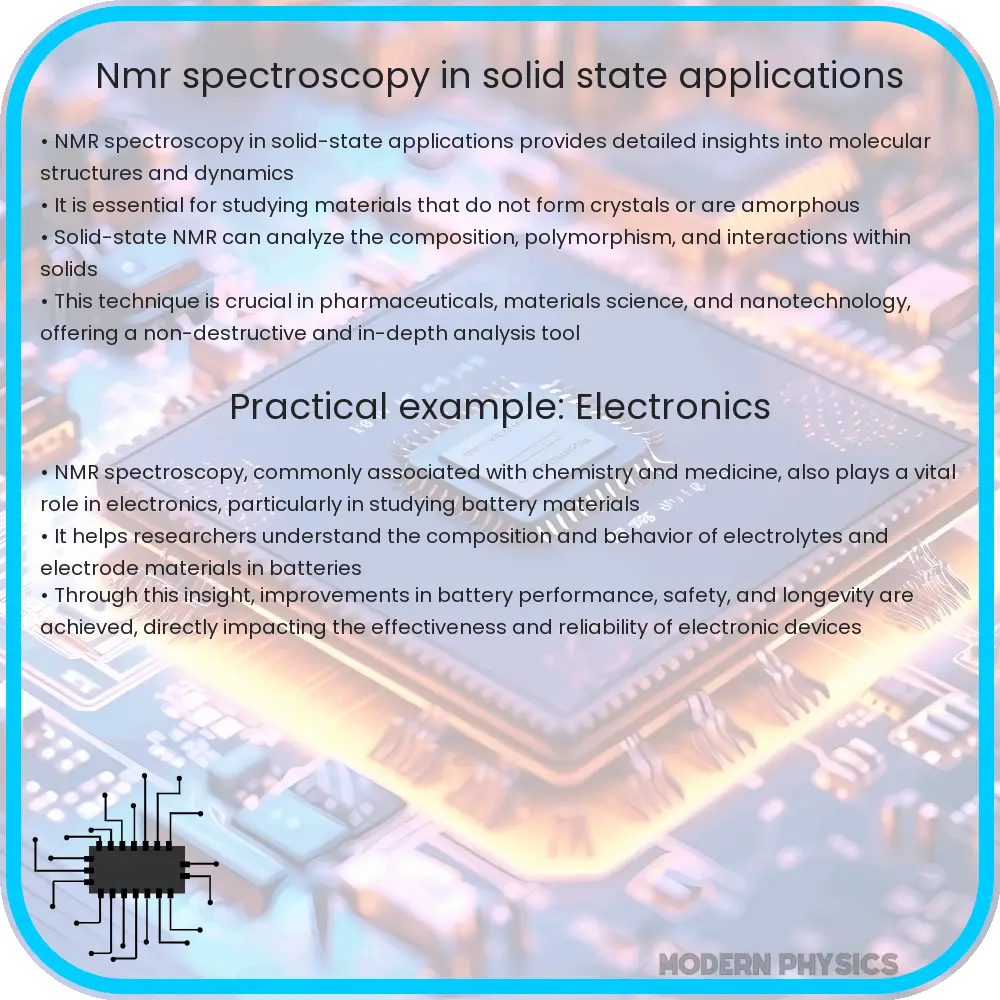Explore how NMR Spectroscopy in solid-state physics unveils material secrets, driving innovations in technology, energy, and pharmaceuticals.

Unlocking the Secrets of Materials with NMR Spectroscopy in Solid-State Physics
Nuclear Magnetic Resonance (NMR) Spectroscopy stands as a pivotal technique in solid-state physics, offering deep insights into the molecular and atomic structure of materials. This advanced analytical method extends beyond the realms of chemistry and biology, embedding itself as a crucial tool in understanding the complex behaviors and properties of solids. Through the manipulation of nuclear spins in a magnetic field, NMR spectroscopy provides unparalleled detail about the internal structure of materials, from the arrangement of atoms to the dynamics of molecular motion.
The Principle Behind NMR Spectroscopy
At the heart of NMR spectroscopy lies the principle of nuclear magnetic resonance, where certain nuclei exhibit magnetic properties when placed in an external magnetic field. The most common nucleus studied in NMR is hydrogen (1H), due to its abundance in organic compounds and biological specimens. When these magnetic nuclei are exposed to a specific radiofrequency, they absorb energy and transition between different energy states. The frequency at which this absorption occurs is highly sensitive to the local chemical environment, making NMR an exquisite probe for structural information.
Applications in Solid-State Physics
In solid-state physics, NMR spectroscopy is employed to explore the atomic-scale structure and dynamics of materials. It plays a crucial role in:
- Material Science: Understanding the lattice structure and defects in crystals, polymers, and glasses.
- Electrochemistry: Investigating the behavior of ions in battery materials and fuel cells, crucial for developing more efficient and durable energy storage systems.
- Pharmaceuticals: Elucidating the polymorphism in drug compounds, which can significantly affect the drug’s efficacy and stability.
Moreover, solid-state NMR techniques such as Magic Angle Spinning (MAS) have revolutionized the ability to obtain high-resolution spectra of solids, overcoming the challenges posed by the broadening of NMR lines typically observed in solid samples. This enhancement allows for the detailed study of molecular structures, dynamics, and interactions within the solid state, offering insights that are invaluable for both research and industrial applications.
Through the lens of solid-state NMR spectroscopy, scientists and researchers gain a deeper understanding of materials at the molecular and atomic level, driving innovations in various fields. From the development of new materials with enhanced properties to the advancement of pharmaceuticals, NMR spectroscopy in solid-state physics is an indispensable tool in the quest to unlock the secrets of materials.
Advancements and Challenges in Solid-State NMR Spectroscopy
As technology progresses, solid-state NMR spectroscopy continues to evolve, pushing the boundaries of what can be discovered about materials. High-field NMR spectrometers and advanced pulse sequences have significantly improved sensitivity and resolution, enabling the study of materials that were previously deemed too challenging. Innovations such as dynamic nuclear polarization (DNP) enhance signal strengths, allowing for the observation of minute quantities of material. Despite these advancements, challenges remain, including the need for high-powered magnets and the inherent complexity of interpreting NMR data, necessitating sophisticated computational methods for analysis.
Future Directions and Impact
The future of NMR spectroscopy in solid-state physics looks promising, with ongoing research focused on enhancing its application range and efficiency. Efforts are being made to develop lower-cost NMR technologies and to simplify data analysis through artificial intelligence and machine learning algorithms. These advancements are poised to broaden the accessibility of NMR spectroscopy, facilitating its use in emerging research areas and industries.
Moreover, the integration of NMR spectroscopy with other analytical techniques, such as X-ray diffraction and electron microscopy, offers a more comprehensive understanding of materials. This holistic approach enables the unraveling of complex material properties and behaviors, contributing to groundbreaking discoveries in nanotechnology, quantum computing, and sustainable materials.
Conclusion
Nuclear Magnetic Resonance (NMR) Spectroscopy in solid-state physics represents a cornerstone of modern material science and research. Its unparalleled ability to provide detailed insights into the atomic and molecular structure of materials has made it an indispensable tool across a wide range of scientific disciplines. Despite its complexities and the challenges associated with advanced NMR techniques, the ongoing developments in this field promise to extend its applicability and efficiency further. As we continue to enhance our understanding and manipulation of materials at the atomic level, NMR spectroscopy will undoubtedly play a pivotal role in driving innovations that address some of the most pressing challenges of our time, from energy storage and sustainability to healthcare and beyond. The journey of NMR spectroscopy, from a fundamental research tool to a driver of technological advancement, underscores the profound impact that deep, atomic-level understanding can have on our world.
